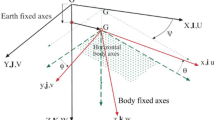Abstract
Some methods for direct stability assessment under the dead ship condition were currently developed by the international maritime organization (IMO) under the Second Generation Intact Stability Criteria. Model tests and simulations are carried out to validate the numerical methods used in assessing the stability under the dead ship condition. This is done in three stages. Firstly, the uncoupled roll mathematical model (1 DOF) is adopted to calculate the roll motion based on the irregular beam waves and the steady wind. Secondly, a drift free experiment is conducted to measure the roll motion under irregular beam waves with zero speed, and then two restrained experiments with counter weights and four springs are performed under the same condition. Finally, the effects of the drift and sway motions on stability under the dead ship condition are then verified by experimental results, and the results of the numerical methods are compared to the results of the model experiments. It is concluded that more accurate numerical methods could be developed for assessing the direct stability under the dead ship condition.
Similar content being viewed by others
References
THEMELIS N., SPYROU K. J. Probabilistic assessment of ship stability[J]. Transactions of the Society of Naval Architects and Marine Engineers, 2007, 115: 181–206.
ISKANDAR B. H., ANDUMEDA N. Some examinations of capsizing probability calculation for an Indonesian RoRo passenger ship in waves[J]. Journal of Kansai Society of Naval Architects, 2001, 236: 81–86.
BULIAN G., FRANCESCUTTO A. Safety and operability of fishing vessels in beam and longitudinal waves[J]. Transactions of the Royal Institution of Naval Architects Part B: International Journal of Small Craft Technology, 2006, 148(2): 1–16.
MCTAGGART, K., ANDDEKAT J. O. Capsizing risk of intact frigates in irregular seas[J]. Transactions of the Society of Naval Architects and Marine Engineers, 2000, 108(492): 147–177.
UMEDA N., IZAWA S. and SANO H. et al. Validation attempts on draft new generation intact stability criteria[C]. Proceedings of the12th International Ship Stability Workshop. Washington DC, USA, 2011, 19–26.
KUBO T., UMEDA N. and IZAWA S. et al. Total stability failure probability of a ship in irregular beam wind and waves: Model experiment and numerical simulaton[C]. Proceedings of 11th International Conference on the Stability of Ships and Ocean Vehicles. Athens, Greece, 2012, 39–46.
OGAWA Y., De KAT J. O. and ISHIDA S. Analytical study of the effect of drift motion on the capsizing pro-bability under dead ship condition[C]. Proceedings of 9th International Conference on the Stability of Ships and Ocean Vehicles. Rio de Janeiro, Brazil, 2006, 1: 29–36.
GU M., LU J. and WANG T. An investigation on stability under dead ship condition of a tumblehome hull[C]. Proceedings of 11th International Conference on the Stability of Ships and Ocean Vehicles. Athens, Greece, 2012, 593–598.
BULIAN G., FRANCESCUTTO A. A simplified modular approach for the prediction of the roll motion due to the combined action of wind and waves[J]. Journal of Engineering for the Maritime Environment, 2004, 218(3): 189–212.
PAROKA D., OHKURA Y. and UMEDA N. Analytical prediction of capsizing probability of a ship in beam wind and waves[J]. Journal of Ship Research, 2006, 50(2): 187–195.
BULIAN G., FRANCESCUTTO A. Experimental results and numerical simulations on strongly nonlinear rolling of multihulls in moderate beamseas[J]. Proceedings of the Institution of Mechanical Engineers-Part M-Journal of Engineering for the Maritime Environment, 2009, 223(2): 189–210.
PAROKA D., UMEDA N. Capsizing probability prediction for a large passenger ship in irregular beam wind and waves: Comparison of analytical and numerical methods[J]. Journal of Ship Research, 2006, 50(4): 371–377.
UMEDA N., KOGA S. and UEDA J. et al. Methodology for calculating capsizing probability for a ship under dead ship condition[C]. Proceedings of the 9th International Ship Stability Workshop. Hamburg, Germany, 2007.
IKEDA Y. Prediction methods of roll damping of ships and their application to determine optimum stabilization devices[J]. Marine Technology, 2004, 41(2): 89–93.
BELENKY V., WEEMS K. M. and LIN W. M. Numerical procedure for evaluation of capsizing probability with split time method[C]. 27th Symposium on Naval Hydrodynamics. Seoul, Korea, 2008.
Author information
Authors and Affiliations
Corresponding author
Additional information
Project supported by Ministry of Industry and Information Technology of China (Grant No. [2012] 533)
Biography: GU Min (1962- ), Male, Master, Professor
Rights and permissions
About this article
Cite this article
Gu, M., Lu, J. & Wang, Th. Stability of a tumblehome hull under the dead ship condition. J Hydrodyn 27, 452–457 (2015). https://doi.org/10.1016/S1001-6058(15)60503-0
Received:
Revised:
Published:
Issue Date:
DOI: https://doi.org/10.1016/S1001-6058(15)60503-0




